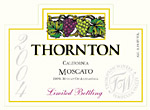 |
|
Wine Details
Price:
$21.00 per bottle
Description:
Our 2005 Moscato is produced entirely from the infamous Muscat of Alexandria, one of the varieties best known for producing the popular sparkling muscat wines of Northern Italy. For our Moscato, we allow the fruit to achieve a higher level of maturity, which contributes to the floral fruit aspects of this rich wine. When served slightly chilled, the perfect balance of crisp sweetness and nice acidity heightens the spicy melon fruit and banana characters on the palate. This Moscato demonstrates wonderful varietal character and superb drink-ability. Enjoy by itself, with fruit, or spicy Asian cuisine.
|
|
Varietal Definition
Muscat of Alexandria:
(aka Muscat Gordo Blanco or Lexia in Australia and Hanepoot in South Africa). Ancient grape species suitable for similar Mediterranean growing climates as the Muscat Blanc above. Makes sweet wines that are usually judged of inferior quality compared to those of the Muscat Blanc cepage varieties. The main use in California is for producing raisins. Also widely grown in Spain, where it is called Moscatel de Alejandria, and Portugal where winemakers in the latter country use it to make "Moscatel de Setubal" sweet wine.
|
Muscat:
Muscat, thought to be one of the oldest grape varieties, is grown worldwide. It is vinified in a multitude of styles, from still to sparkling, and dry to sweet to fortified. Also called Moscato, Moscatel and Muskateller, it is a sweetly aromatic, fruity grape that has many genetic variations and colors. It probably originated in Greece but maybe the independent sultanate of Muscat in the southeast of the Arabian Peninsula had something to do with it. Over 200 different varieties and derivatives to the Muscat family exist today. Muscat Canelli, Orange Muscat and Black Muscat are varieties most planted in California, which makes primarily still wine. More unusual is Muscat fermented to total dryness, which leaves greater alcohol levels and no residual sugar. Some Muscats are aged in oak to provide additional complexity.Today’s recommended Muscats represent many of these styles, so use the tasting notes and percent of residual sugar - listed if provided by the winery - to find a wine you’ll enjoy. The more sugar and the lower the alcohol, the sweeter the wine, though wines above 10 percent alcohol can also be somewhat sweet.
|
|